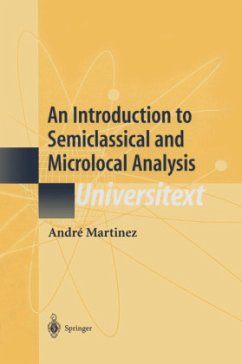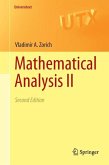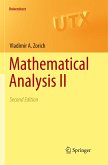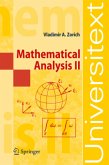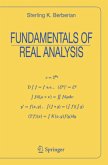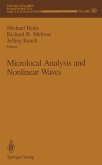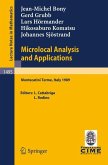The following lecture notes correspond to a course taught for several years, first at the University of Paris-Nord (France) and then at the University of Bologna (Italy). They are mainly addressed to nonspecialists in the subject, and their purpose is to present in a pedagogical way most of the techniques used in the microlocal treatment of semiclassical problems coming from quantum physics. Both the standard Coo pseudodifferential calculus and the analytic microlocal analysis are developed, in a context that remains intentionally global so that only the relevant difficulties of the theory are encountered. The main original ity lies in the fact that we derive all the main features of analytic microlocal analysis from a single a priori estimate, which turns out to be elementary once the Coo pseudodifferential calculus is established. Various detailed exercises are given at the end of the main chapters, most of them being easily solvable by students. Besides illustrating the main results of the lecture, their aim is also to introduce the reader to various further developments of the theory, such as the functional calculus of pseudodifferential operators, properties of the analytic wave front set, Gevrey classes, the use of coherent states, the notion of semiclassical measures, WKB constructions. Applications to the study of the Schrodinger operator are also discussed in the text, so that they may help the understanding of new notions or general results where they appear by replacing them in the context of quantum mechanics.
From the reviews:
"The book is very clearly written, and is indeed much simpler than most of others. ... this is an excellent book, suitable even for students with a poor background in the subject. In my opinion, every department offering courses on partial differential equations or asymptotic analysis should have it in the library. It will be very useful to all mathematicians working in semi-classical or microlocal analysis ... ." (Yuri Safarov, Bulletin of the London Mathematical Society, Issue 35, 2003)
"This is a concise and accessible book on the basic techniques of semiclassical and microlocal analysis. ... An appendix provides a useful summary of the major formulas used in the text. Each chapter is followed by a collection of provocative and well chosen exercises. The exercises are essential for understanding the work and provide important applications. ... the text does provide a very readable, clear, and concise introduction to semiclassical and microlocal analysis." (Peter D. Hislop, Mathematical Reviews, 2003 b)
"The contents of the book correspond to a course at Ph. D. Level, given by the author at the Universities of Bologna and Paris-Nord. ... the book collects in an original way standard results and new aspects of semi-classical microlocal analysis; the reading is suggested to non-specialists as well." (L. Rodino, Zentralblatt MATH, Vol. 994 (19), 2002)
"This book presents most of the techniques used in the microlocal treatment of semiclassical problems coming from quantum physics. ... The originality lies in the fact that the main features of analytic microlocal analysis are derived from a single and elementary a priori estimate. Various exercises illustrate the chief results of each chapter while introducing the reader to further developments of the theory. Applications to the study of the Schrödinger operator are also discussed, to further the understanding of new notions ... ." (L' EnseignementMathematique, Vol. 48 (1-2), 2002)
"The book under review consists of lecture notes corresponding to a course taught for several years at the universities of Paris-Nord (France) and Bologna (Italy). It is addressed mainly to non-specialists in the subject, and the prerequisites are essentially reduced to the basic notions of the theory of distributions. ... The author tries to make clear how the things work and show examples where they can be applied. It is nicely written ... . the book can be highly recommended." (J. Synnatzschke, Zeitschrift für Analysis und ihre Anwendungen - ZAA, Vol. 21 (3), 2002)
"The book is very clearly written, and is indeed much simpler than most of others. ... this is an excellent book, suitable even for students with a poor background in the subject. In my opinion, every department offering courses on partial differential equations or asymptotic analysis should have it in the library. It will be very useful to all mathematicians working in semi-classical or microlocal analysis ... ." (Yuri Safarov, Bulletin of the London Mathematical Society, Issue 35, 2003)
"This is a concise and accessible book on the basic techniques of semiclassical and microlocal analysis. ... An appendix provides a useful summary of the major formulas used in the text. Each chapter is followed by a collection of provocative and well chosen exercises. The exercises are essential for understanding the work and provide important applications. ... the text does provide a very readable, clear, and concise introduction to semiclassical and microlocal analysis." (Peter D. Hislop, Mathematical Reviews, 2003 b)
"The contents of the book correspond to a course at Ph. D. Level, given by the author at the Universities of Bologna and Paris-Nord. ... the book collects in an original way standard results and new aspects of semi-classical microlocal analysis; the reading is suggested to non-specialists as well." (L. Rodino, Zentralblatt MATH, Vol. 994 (19), 2002)
"This book presents most of the techniques used in the microlocal treatment of semiclassical problems coming from quantum physics. ... The originality lies in the fact that the main features of analytic microlocal analysis are derived from a single and elementary a priori estimate. Various exercises illustrate the chief results of each chapter while introducing the reader to further developments of the theory. Applications to the study of the Schrödinger operator are also discussed, to further the understanding of new notions ... ." (L' EnseignementMathematique, Vol. 48 (1-2), 2002)
"The book under review consists of lecture notes corresponding to a course taught for several years at the universities of Paris-Nord (France) and Bologna (Italy). It is addressed mainly to non-specialists in the subject, and the prerequisites are essentially reduced to the basic notions of the theory of distributions. ... The author tries to make clear how the things work and show examples where they can be applied. It is nicely written ... . the book can be highly recommended." (J. Synnatzschke, Zeitschrift für Analysis und ihre Anwendungen - ZAA, Vol. 21 (3), 2002)

